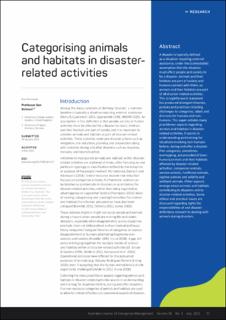| dc.date.accessioned | 2022-04-26T08:48:22Z | |
| dc.date.available | 2022-04-26T08:48:22Z | |
| dc.date.created | 2021-07-28T14:47:52Z | |
| dc.date.issued | 2021 | |
| dc.identifier.citation | Kelman, I. (2021). Categorising animals and habitats in disaster-related activities. Australian Journal of Emergency Management, 36 (3), 57-62. | en_US |
| dc.identifier.issn | 1324-1540 | |
| dc.identifier.uri | https://hdl.handle.net/11250/2992738 | |
| dc.description.abstract | A disaster is typically defined as a situation requiring external assistance, under the (contestable) assumption that the situation must affect people and society to be a disaster. Animals and their habitats are part of society and humans connect with them, so animals and their habitats are part of all disaster-related activities. This straightforward statement has produced divergent theories, policies and practices including challenges to categories, labels and divisions for humans and non-humans. This paper collates many practitioner aspects regarding animals and habitats in disaster-related activities. It assists in understanding and training for situations involving non-humans before, during and after a disaster. Five categories, sometimes overlapping, are provided of (non-human) animals and their habitats affected by disaster-related activities: companion animals, service animals, livelihood animals, captive animals and wildlife and wildland animals. Other aspects emerge about animals and habitats contributing to disasters and to disaster-related activities. Some ethical and practical issues are discussed regarding rights for, responsibilities of and disaster definitions relevant to dealing with animals during disasters. | en_US |
| dc.language.iso | eng | en_US |
| dc.publisher | Emergency Management Australia | en_US |
| dc.rights | Navngivelse-Ikkekommersiell 4.0 Internasjonal | * |
| dc.rights.uri | http://creativecommons.org/licenses/by-nc/4.0/deed.no | * |
| dc.title | Categorising animals and habitats in disaster-related activities | en_US |
| dc.type | Peer reviewed | en_US |
| dc.type | Journal article | en_US |
| dc.description.version | publishedVersion | en_US |
| dc.rights.holder | 2021 The Author(s) | en_US |
| dc.subject.nsi | VDP::Samfunnsvitenskap: 200::Økonomi: 210 | en_US |
| dc.source.pagenumber | 57-62 | en_US |
| dc.source.volume | 36 | en_US |
| dc.source.journal | Australian Journal of Emergency Management | en_US |
| dc.source.issue | 3 | en_US |
| dc.identifier.doi | 10.47389/36.3.57 | |
| dc.identifier.cristin | 1922885 | |

